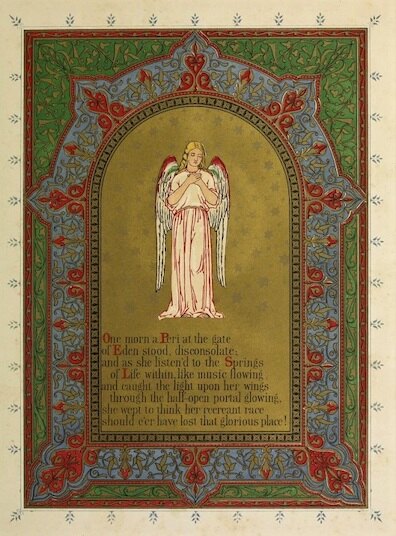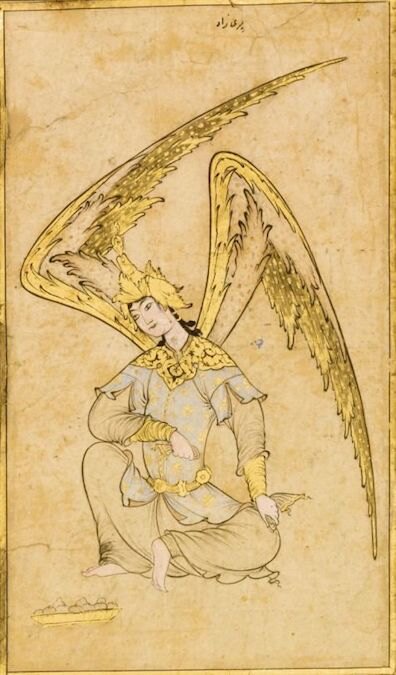Paradise and the Peri
Paradise and the Peri
In Brief
When the tram passes between Bloom and the woman he is eyeing
for a glimpse of underwear, and he realizes that he has "Lost
it," he thinks of "Paradise and the peri," a verse tale by the
Irish poet Thomas Moore. The peri is an angel- or fairy-like
being of Persian mythology who is shut out of paradise.
Read More
Moore (1779-1852), who was probably inspired by the presence
of peri in William Beckford's oriental novel Vathek
(1786), created "Paradise and the Peri" as one of four
interpolated tales within a frame story titled Lalla
Rookh, an Oriental Romance (1817). After his death it
was published in a stand-alone volume from which the
illustration beside this note is taken. Robert Schumann wrote
a cantata called Paradise and the Peri (1843) based on
a translation of Moore's work, and Thomas Crawford made a
life-size marble sculpture called Peri at the Gates of
Paradise (ca. 1856).
The peri originated in Persia and later spread to Armenia,
Turkey, and India. They were lovely female spirits, devoted to
beauty and generally well-disposed toward both human beings
and God, who were nevertheless denied a place in paradise
because of some unnamed mischief. In the version of their
story told by the poet-king in Moore's Lalla Rookh,
one peri struggles to gain entrance into heaven. The tale
begins with the verses inscribed in the first of the images
here:
One morn a Peri at the gate
Of Eden stood, disconsolate;
And as she listen'd to the Springs
Of Life within, like music flowing,
And caught the light upon her wings
Through the half-open portal glowing,
She wept to think her recreant race
Should e'er have lost that glorious place!
A "glorious angel" who is guarding the gate takes pity on the
peri and tells her that she can be admitted if she offers "the
gift that is most dear to Heaven." She speeds off to earth
looking for this precious substance, and returns twice with
gifts that do not fit the bill. On her third try she
encounters a "man of crime" who sees a young boy playing and
weeps "tears of soul-felt penitence." One of these blessed
tears from his cheek gets the peri into paradise.
In Bloom's application, the story of the peri is essentially
turned on its head. Instead of a beautiful female spirit
gazing past the pearly gates into a heaven whose incorporeal
splendors she longs to taste, he stands outside the gates of
the Grosvenor hotel gazing at a beautiful female and longing
to get inside her drawers.
Bloom's brief recollection of Moore's orientalizing work is
one of a long catalogue of passages that show Joyce's interest
in the Persian and Arab cultures of the Middle East. In some
of these passages exoticism amplifies eroticism, and vice
versa. In "Araby," the third story of Dubliners, the
boy carries his intoxicating image of Mangan's sister "even in
places the most hostile to romance," and when she asks him
whether he will be going to the "splendid bazaar" that is
coming to town he thinks he has found an objective correlative
for his subjective passion: "At night in my bedroom and by day
in the classroom her image came between me and the page I
strove to read. The syllables of the word Araby were
called to me through the silence in which my soul luxuriated
and cast an Eastern enchantment over me."
Bloom's investment in this strain of oriental eroticism
surfaces repeatedly in Circe. Molly appears to him "in
Turkish costume"—"scarlet trousers and jacket,
slashed with gold," a yellow sash around her waist, a
coin on her forehead, jewelled rings on her toes, "a
slender fetterchain" on her ankles, and a "white
yashmak, violet in the night," covering her face. As he
stands flirting with Zoe outside of Bella Cohen's house, his
hand "feeling for her nipple," she says, "Stop that and
begin worse. Have you cash for a short time? Ten shillings?"
Bloom's reply: "More, houri,
more."

